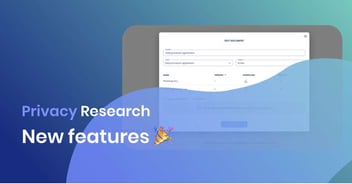New features: .legal GRC platform - November 2024 🎊
Our platform has undergone an exciting transformation! Formerly known as "Privacy," it is now the .legal GRC Platform, reflecting our broadened focus and enhanced capabilities. This change represents our journey from managing personal data compliance to providing a comprehensive solution for governance, risk, and compliance (GRC). From data protection and cybersecurity to vendor management, the .legal GRC Platform empowers organizations to simplify and streamline their compliance efforts.
In this blog post, we’ll highlight key updates to the platform, including improved legal entity management, enhanced public audit features, and new policy types to better serve your compliance needs. Dive in to explore how these updates make compliance management more intuitive and efficient than ever.
From "Privacy" to ".legal GRC Platform"
Maybe you already have noticed? We have changed our platform name from Privacy to .legal GRC platform. This has been done to better reflect our expanded focus and capabilities. While we started by helping organisations manage personal data compliance, our platform now addresses a broader range of compliance needs. From Data Protection and Information- & Cyber Security to Vendor Management, the .legal GRC platform simplifies and streamlines these critical tasks, fostering collaboration and ensuring robust governance across multiple areas of compliance. This new name captures the platform's evolution and commitment to comprehensive compliance management. This is why you will see a new logo within the platform and maybe notice that some texts have changed.

Improved overview of deactivated legal entities
We’ve enhanced the management of legal entities with a new "Legal Entity Status" filter, designed to provide greater clarity and control. This feature allows you to easily filter between active and deactivated legal entities, giving you a streamlined overview. By default, the list displays both active and deactivated entities, with deactivated ones clearly marked by a grey bar to indicate their inactive status. This visual enhancement makes it easier to distinguish and manage entities at a glance.

What does it mean that a legal entity is deactivated?
Deactivating a legal entity instead of deleting it ensures that its historical data and audit trails are preserved, which is often critical for compliance, reporting, and transparency. By deactivating an entity, you can prevent it from being actively used in workflows while still retaining access to its records for reference, legal requirements, or internal reviews. This approach helps maintain data integrity and ensures that past actions linked to the entity remain traceable, avoiding potential issues with incomplete records or compliance audits.

Description field on legal entities
We’ve introduced a description field for all legal entities in step 1 of the creation and editing process. This field allows you to briefly outline the context in which the legal entities/vendors are used and the services they provide, helping to add clarity and additional details for better tracking and management. The description will also be shown in the overview under the information icon right next to the legal entity name.

User comment on public audit (Vendor Management)
When creating a public link to an internal assessment the user can now make a comment to the assessment. For example, if a generel DPIA template should be answered, the user can include a comment specifying which project the DPIA will be answered in relation to. These comments will also appear in the internal assessments overview as tooltips when hovering over the assessment titles in the list.

New types on policies
Lastly, we’ve expanded the policy creation process by adding new policy types to better address various compliance needs. You can now easily create the following policy types:
- Whistleblower Policy: Establish clear guidelines and procedures for reporting misconduct, ensuring transparency and protecting whistleblowers.
- Employee Instruction: Provide detailed instructions for employees, outlining company policies and procedures to ensure compliance and awareness.
- Privacy Policy for Customers: Clearly communicate how customer data is collected, used, and protected, enhancing trust and compliance with privacy regulations.

We hope you will enjoy the new features 🎉











.jpg)


.jpeg)

.jpg)
.jpg)



.jpg)

-1.png)



.jpeg)








.jpg)

